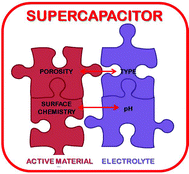The effect of the carbon surface chemistry and electrolyte pH on the energy storage of supercapacitors
Abstract
Energy storage in supercapacitors can be enhanced by optimising the electrostatic mechanism and the pseudo-faradaic reactions. In the latter case, it is essential to take into account the surface chemistry of the electrode material and the pH of the electrolyte. In this work, supercapacitors were assembled using three carbon xerogels containing different oxygen surface groups and various aqueous media (Na2SO4, H2SO4 and KOH), in order to evaluate the influence of the surface chemistry on the electrochemical behaviour of the cells. However, it is not only necessary to take into account the chemical nature of the electrodes, but also the combination of this surface chemistry and the pH of the electrolyte, since the performance of the electrode material depends on the type of electrolyte medium used. In the case of a carbon xerogel with quinone-type oxygen groups, it has been demonstrated that there are pseudo-capacitive effects when the pH of the electrolyte is lower than the point of zero charge (pHPZC) of the electrodes, i.e., when the electrode surface is positively charged. However, in the case of an alkaline electrolyte, the carbon samples studied presented similar capacitance values, suggesting that the negative charges make a lower contribution in these carbon-based energy storage systems.


 Please wait while we load your content...
Please wait while we load your content...